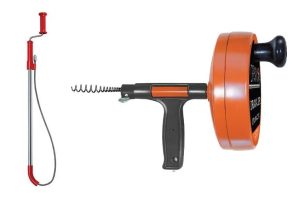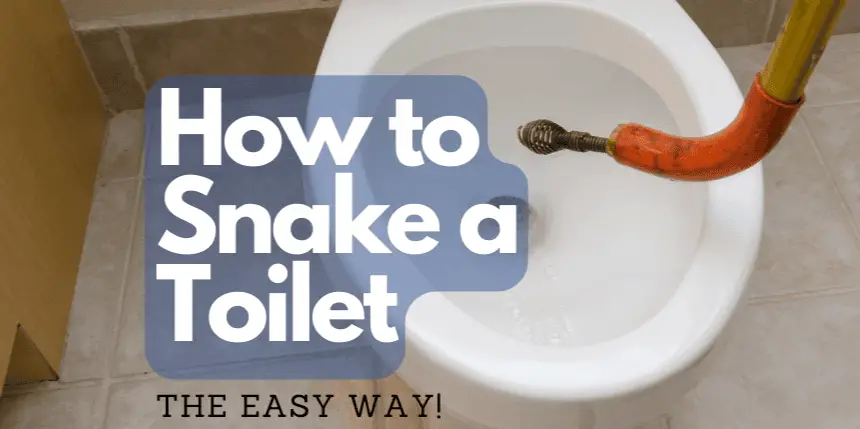You’re not alone in this – we’ve all been there. That moment when you flush the toilet, only to cringe as the water keeps rising. Its a brief moment of panic, thinking of that potential messy overflow disaster! Knowing how to snake a toilet is not a common DIY trait. But fear not, I’m here to help you navigate through the murky waters of toilet snaking like a pro.
We’ll walk you through identifying the source of your blockage, choosing the proper tools for the job and how to use them to clear the toilet without causing any damage.
I will even throw in some proper plunging techniques and safety tips just for good measure. Its not a glamorous task, this toilet-clog-clearing, but it’s got to get done.
So grab your trusty plunger, go borrow, rent or buy a toilet auger and roll up your sleeves. Let’s dive into learning how to snake a toilet safely and easily together – because no one should have to face this challenge blind!
Now lets clear this up; toilet snakes go by a whole ton of different terms. They’re known as closet snakes, drain augers, plumbers snakes and drain snakes. These terms are all interchangeable, with some commonly used more for the longer types of augers that can go dozens of feet into plumbing pipes!
Identifying the Clog
So, you’ve got a clogged-up situation on your hands – let’s figure out what’s causing the issue! Before we get to the nitty-gritty of how to snake to unclog a toilet (<– skip to it), we need to identify what kind of clog you’re dealing with.
There are two types of clogs: one is caused by an obstruction in the pipe, while the other is due to build-up from waste materials. Knowing which type you have will make your life way easier when it comes time to unclog your toilet.
To identify your problem, grab that trusty toilet plunger and give it a few good plunges. If water starts draining and things clear up quickly, congrats – you’re in luck! There is a great chance that you can skip using the drain snake entirely, as the clog will likely clear with only plunging.
Follow below for proper toilet plunging:
Proper Plunging Techniques
So you might be in the clear with just plunging your toilet. Especially if its just a blockage from toilet paper or regular waste.
Before getting started, make sure you have the right tool for the job. A toilet plunger with a flange, as opposed to a flat-bottomed sink plunger. The flange on a toilet plunger is made for toilets and gives proper suction on the uneven bottom of the toilet bowl.

Now that you have your toilet plunger in hand, grabs some paper towels or a bath towel to wipe up a few splashes that will happen. Now let’s go through the easy step-by-step usage how to plunge your toilet:
- First, make sure there’s enough water in the bowl to cover the head of your plunger. This helps to give enough seal for maximum suction. If you water is very low, give it a flush to fill.
- Next, dip the plunger at an angle so that it fills with water. Place the end of the plunger into the toilet bottom drain.
- Then, apply firm smooth motion, pushing down and ensuring that you maintain your grip on the handle. You will feel the resistance of both the rubber plunger itself, water pressure and the force of the blockage resisting.
- Pull up sharply but carefully. Try to avoid rapid movements, as there will be splashing. Firm, deliberate plunging motion is best.
- Repeating steps three and four several times if necessary until you dislodge whatever is causing your clog. Re-fill your toilet bowl as needed, if the water level falls but the clog remains.
Remember: practice makes perfect! As part of our community tackling DIY home repairs together, we all need time to develop our skills and get comfortable using tools like plungers in our homes. So don’t be discouraged if your first few attempts aren’t successful.
Pretty much nobody has a good time their first plunging experience! Its gets easier, I promise!
If, unfortunately, this didn’t not budge your blockage in the toilet, its time to move onto the next phase; using your drain/toilet snake.
Using a Toilet Snake
Since the water level has stayed high or barely drains at all, it’s time to use a toilet auger or plumbing snake. This pro-level plumbers tool can help reach deep into the pipes and break through stubborn blockages. It’s basically a last-resort tool when it comes to a clogged toilet, but it is super-effective. Its almost a guaranteed win.
When working with a toilet snake, remember to be fairly gentle when inserting the end of the snake into your toilet bowl; after all, we want our toilets intact and working well after we clear them out! Patience pays here.
Using a drain auger to unclog your toilet is actually easier than it sounds. Once you’ve figured out the technique, you’ll be a part of an exclusive club; those who can fearlessly tackle plumbing problems like a pro. Seriously though, it will come in handy to know this! Nobody wants to have their toilet bowl out of commission.

Now that you’re armed with your trusty drain auger, let’s dive into the glamorous world of clog-busting and clear that toilet ASAP!
How to Use a Toilet Snake
Step 1: Preperation
To begin, lay a couple of towels around the base of the toilet. Have your special tool, the drain snake ready beside the toilet. Put on a pair of rubber gloves or latex gloves and get ready.
Step 2: Positioning the Auger
Carefully insert the snake into the entrance of the drain with the curved end facing up. This will help protect the porcelain of your toilet from any accidental scratches or damage. Porcelain is durable, but can be chipped or scratched somewhat easily.
Step 3: Snaking the Toilet Drain
As you gently push the snake further down into the pipe, rotate the handle clockwise to help break up and dislodge any obstructions. If you feel resistance or if turning becomes difficult, that means you’ve reached the clog – don’t worry; this is where things get interesting!
Step 4: Clearing the Clog
Keep giving pressure while continuing to turn the handle. Eventually you’ll break through or latch onto whatever was causing the blockage.
Step 5: Removing the Snake
Once you that happens, slowly pull back on your drain auger while still turning it counterclockwise to retrieve as much debris as possible.
Step 6: Success (hopefully!)
This should result in the blockage being cleared, and the toilet draining completely. If the clog remains, repeat the steps as needed.
And just like that – mission accomplished! Welcome to our elite group of fearless DIY plumbers!
Operating an Electric Snake
When tackling more stubborn clogs, an electric drain snake makes the job a lot easier. These special tools offer a powerful solution to get things flowing once again. Operating one of these might seem intimidating at first but don’t fret; they’re actually easier than their manual counterparts when used correctly.
Here’s how to use an electric drain snake:
Step 1: Put on your rubber or latex gloves and layout a couple towels around the base of your toilet.
Step 2: Just like when you use a drain snake manually, start by feeding the auger into the drain opening, being careful to not scratch the porcelain.
Step 3: Guide the auger into the drain until you feel resistance, when you’ve reached the clog. Hold the auger motor base firmly, turn the auger on. Gently push the auger forward while running to break through whatever’s causing that plumbing chaos.
Step 4: Be patient and move slowly, let the electric auger do its thing. Feel for the resistance to give way, indicating that the auger is all the way through your drain blockage. Don’t worry if this takes a bit, but listen carefully for indication of what’s happening in the drain. If something sounds or feels off, stop the auger and reassess.
Step 5: Once you are confident that the blockage is cleared, slowly pull the snake out of the toilet drain while still leaving the auger turning. This should pull out the clog, and water will freely drain!
See, this really was pretty easy. A bit messy, but it can feel good to overcome a crappy situation like this! Right?!
Plumbing Safety Tips
It’s good peace-of-mind to follow basic safety tips while you’re tackling those pesky clogs and mastering your plunging skills. Snaking a toilet is an effective task for clearing stubborn blockages, but it’s important to approach with a bit of caution. To do this safe and easy way, start by protecting yourself and your surroundings.
Always wear rubber or latex gloves when working on your plumbing. You’re almost certain to get a bit dirty and they will protect your hands from bacteria. Gloves also give you a way better grip on the tools like the snake or plunger, especially when things get a bit wet.
For basic area prep, use old towels or rags to cover the floor around the toilet base to prevent water seeping and slipping hazards while you work.
One of the most critical plumbing safety tips is being mindful of your toilet’s porcelain. When you snake a toilet, ensure that you’re using a tool specifically designed for toilets – these snakes typically have protective coverings that help prevent scratches or damage to the porcelain bowl.
Use firm-gentle pressure when inserting and moving the snake through the drain as too much force could lead to cracks or breaks in your toilet. You don’t want that!
If you encounter significant resistance that doesn’t budge after several attempts, don’t force it further; instead, seek professional assistance from a plumber. Just like potential damage to your toilet bowl from carelessness, your plumbing pipes can also suffer damage if you push things too far.
By following these tips, you’ll should be able to clear your drains without much worry or effort!
When to Call a Plumber
You might feel like a plumbing Wizard after mastering the art of snaking, but there are times when it’s best to hang up your cape and call in the professionals.
Knowing when to call a plumber can save you time, money, and potential damage to your home.
- If you’ve tried snaking your toilet the safe and easy way but the toilet clog persists, it’s definitely time to call a plumber.
- If you notice water seeping from under your toilet or damp spots around the base. This could indicate a more serious issue beyond just a simple clog.
Don’t let pride get in the way of making smart decisions for your home – remember that even seasoned DIY-ers need help sometimes!
So next time you face an overwhelming toilet clog or other plumbing conundrums, take comfort in knowing that reaching out for professional help is not only practical but also connects you with others who share similar experiences.
Wrap Up
It’s a dirty job, but snaking a toilet can be a simple and effective solution for very stubborn clogs. Just remember to choose the right tool, follow proper techniques, and prioritize safety.
Imagine the satisfaction of resolving that pesky blockage without calling in a professional plumber! So next time you’re faced with an obstructed toilet, give these methods a try.
Not only will you save money on plumbing services, but you’ll also gain valuable DIY skills and confidence in maintaining your home’s plumbing system.



